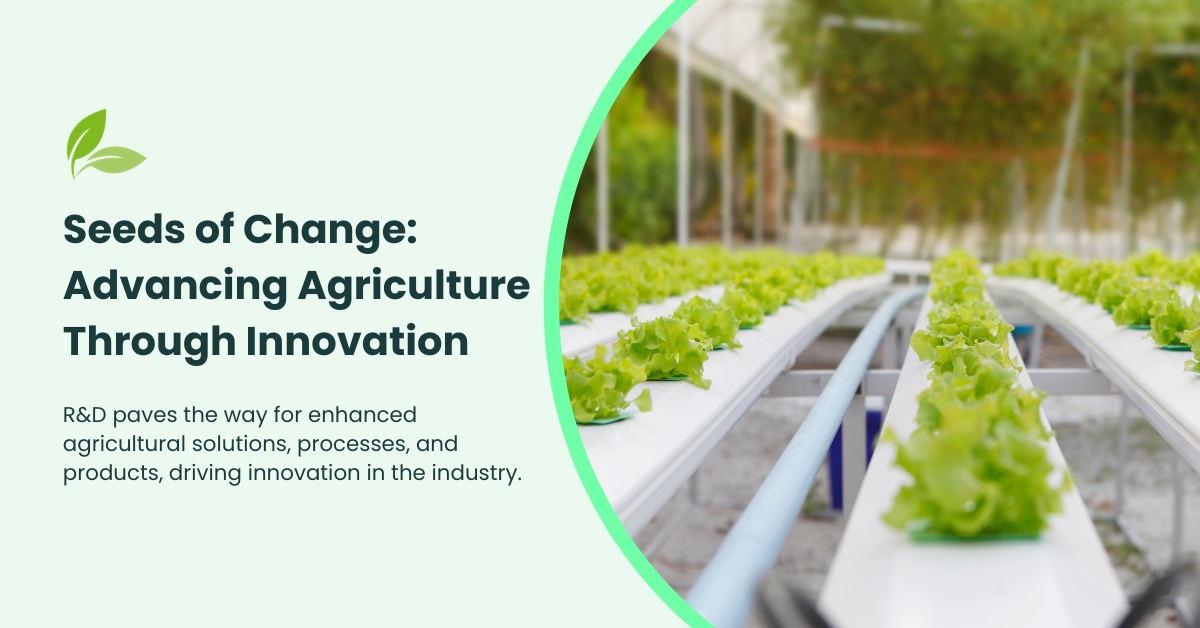With the news reporting on record-high temperatures, labour shortages, and a growing population to feed, R&D in agriculture offers an opportunity to flourish. A successful R&D claim can provide the financial boost needed to drive the agriculture industry toward improved solutions, processes, and products, ultimately overcoming the industrial challenges. This article will provide comprehensive information on the significance of R&D in addressing challenges faced by the agriculture industry and the advantages industry experts can expect to receive when applying for R&D tax credits.
The challenges faced within the agricultural industry
R&D tax credit opportunities lie within tackling key industry challenges. The government is actively encouraging and supporting UK businesses that are involved in scientific and/or technological innovation by reducing corporation tax bills or providing a payable tax credit. In the context of agriculture, here are some examples of agricultural industry challenges that require out-of-the-box thinking and an investment of time and expenditure to resolve through R&D activities:
Climate change
Climate change is impacting the agricultural sector in a number of ways. Firstly, the UK has a Net Zero target; a legally binding commitment to reduce the UK’s greenhouse gas emissions to a level where the country no longer contributes to global warming, by the year 2050. Certain agricultural operations cause a detriment to the environment. For example, a 2021 government report states there is a 28% failure rate for meeting standards of the Water Framework Directive; an EU legislative set of standards that detail best practices to prevent water pollution. Water pollution is caused by the drainage of fertilisers, pesticides, slurry, and soil erosion from agricultural land.
Another way climate change is challenging farmers’ work is the disruption of crop production and reduced yields due to more frequent and severe weather events, such as droughts and floods. How do the practices of farmers adapt to rising temperatures to maintain food quality and safety?
According to the Agri-climate report 2022, 58% of farmers were taking action to reduce emissions. These actions typically involve innovative thinking; challenging the “normal” way to find a new solution, even if it seems initially uncertain. Lots of these actions would most likely be eligible for R&D tax credits.
A growing population
With increased demand, there is greater emphasis on land, water, and other natural resources, which can lead to overuse and degradation. The United Nations states: “The global human population reached 8.0 billion in mid-November 2022 from an estimated 2.5 billion people in 1950, adding 1 billion people since 2010 and 2 billion since 1998. The world’s population is expected to increase by nearly 2 billion persons in the next 30 years”.
Currently, the agriculture industry provides half of the food we eat and employs just under half a million people. With a growing population, farming needs to be resilient to keep up with this rate of growth. R&D would be looking at how to increase the efficiency of farming practices to prevent wastage and maximise output.
Labour shortages
Difficulty in finding and retaining skilled labour in agriculture is a common issue, especially in rural areas. Increasing labour shortages mean the agriculture industry will struggle to meet targets. Many agricultural tasks are highly seasonal, such as planting and harvest seasons. Labour shortages can lead to delays, reduced crop yields, and economic losses if there aren't enough workers during these critical periods. The COVID-19 pandemic impacted labour shortages, as well as markets, distribution networks, and pricing. The agricultural labour force is ageing, and younger generations are less inclined to pursue careers in farming. This demographic shift exacerbates labour shortages as experienced farmers retire without sufficient replacements. Research and development is needed to use technology to mitigate these shortages.
Damage to biodiversity
The agriculture industry contributes to damage to biodiversity through several mechanisms including habitat conversions where natural habitats are cleared to make room for agricultural purposes, and the use of pesticides, herbicides, and fertilisers can harm non-target species and disrupt ecological balances, affecting both flora and fauna.
Damaging biodiversity poses a significant challenge to the agriculture industry as it disrupts the delicate ecological balance essential for crop pollination, pest control, and soil health. Reduced biodiversity can lead to the proliferation of pests and diseases, requiring increased pesticide use and additional management efforts. Furthermore, the decline in pollinator populations, like bees, threatens the fertilisation of many crops, potentially resulting in reduced yields and economic losses. Loss of biodiversity can also lead to soil degradation and reduced fertility, as diverse ecosystems contribute to nutrient cycling and soil health. Ultimately, the agriculture industry heavily depends on the services provided by a diverse array of species, making the conservation of biodiversity essential for sustainable and productive farming practices.
R&D tax credits for the agriculture industry are rewarded to businesses exploring how to protect biodiversity. This is a core component of organic farming which only 3% of the agriculture industry is involved in.
Fluctuating prices
Due to the invasion of Ukraine, food prices went up, contributing to the cost of living crisis. There was an increased labour shortage because Ukrainians comprised 67% of the temporary workers granted Seasonal Worker visas. Due to the imposition of martial law in Ukraine, prompted by the Russian invasion, has restricted Ukrainian men aged 18 to 60 from leaving the country, and are unable to assist in the UK’s agriculture industry. According to data from the UK Government, individuals from Ukraine and Russia accounted for 43% and 5%, respectively, of the 6,618 individuals who arrived in the UK through the Seasonal Worker scheme from January 1, 2022, to March 31, 2022.
The conflict led to a 50% surge in the value of wheat, with a 35% elevation in the per-unit cost, primarily driven by the disruption in the global cereals market stemming from the global trade disturbances caused by the Ukrainian war.
How is R&D in agriculture changing industry practices?
It’s clear that there are challenges within the agriculture industry. This means there is a large scope of R&D opportunities. The UK government encourages farmers and others involved in the agricultural industry to overcome these challenges with technical or scientific discovery. Let’s go through some examples of eligible agriculture projects:
Involvement of AgriTech in agricultural operations
Agritech, or agricultural technology, is a sector that leverages innovative digital and technological solutions to enhance and streamline various aspects of farming and agricultural practices. In simple terms, it is the use of technology in agriculture. It encompasses the use of data analytics, automation, and advanced tools to improve crop production, livestock management, resource efficiency, and overall sustainability in the agriculture industry. Examples of AgriTech include:
- Precision farming - The AgriTech strategy enables farmers to use data and technology for precise planting, irrigation, and fertilisation, optimising resource use and increasing crop yields.
- Livestock monitoring - AgriTech includes wearable sensors and tracking systems for livestock that help monitor the health and behaviour of animals, improving their well-being and productivity.
- Smart irrigation - AgriTech incorporates automated irrigation systems that adjust water usage based on weather conditions and soil moisture, reducing water waste, and conserving resources in agriculture.
Crop improvement
Developing new crop varieties through selective breeding, genetic modification, or other innovative techniques to enhance traits like yield, disease resistance, or drought tolerance.
Pest and disease management
Researching and testing novel methods for controlling pests and diseases, including the development of natural pesticides, integrated pest management systems, or disease-resistant crop varieties.
Soil health and management
Investigating methods to improve soil fertility, reduce erosion, and enhance nutrient cycling through practices like cover cropping, conservation tillage, and organic matter management.
Livestock health and genetics
Researching and breeding programs to improve the health, productivity, and genetics of livestock, including disease resistance and feed efficiency.
Sustainable farming practices
Studying and adopting sustainable practices that reduce environmental impacts, such as agroforestry, organic farming, and regenerative agriculture.
Water management
Innovations in water-saving techniques, like smart irrigation systems and rainwater harvesting, to improve water use efficiency in agriculture.
These are just a number of examples of eligible R&D in agriculture. There is so much scope and variety to what counts as R&D which is why we always recommend speaking to an R&D tax credit specialist to check your eligibility and ensure you don’t miss out!
Key takeaways
The existence of industry challenges reveals the mass of opportunities for R&D in the agriculture industry. British farming is a hotspot of investment opportunities. This financial boost is transformative and should not be slept on! Advancement is crucial in agriculture and the government’s tax incentive provides rewards to UK businesses who dare to question the normal way of doing agricultural practices, for greater benefits across the industry.
How to receive R&D tax credits for agriculture?
It’s incredible to watch the agriculture industry evolve to meet sustainable goals and feed more mouths. As R&D tax credit specialists, our primary passion is innovation. We inject this passion into each R&D claim that has resulted in over 2400 positive phone calls announcing the R&D tax credits on their way to our clients. We understand the natural problems that can arise while claiming and what makes HMRC enquire about your claim, delaying the process which is why our stringent ad hoc compliance processes proactively avoid these problems. If you’re not 100% sure whether you’re eligible for R&D tax credits in the agricultural industry, you can book a free consultation to discuss your eligibility.


No comments yet